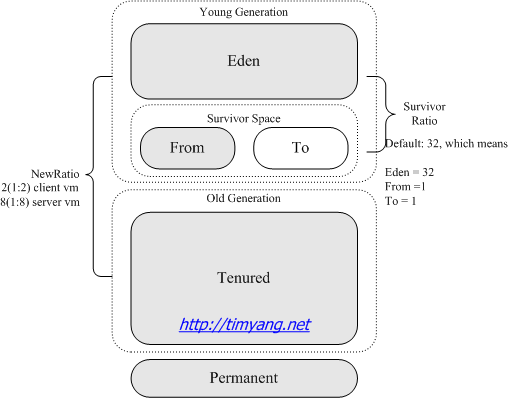我的手机没有农历日历,想搜索一个WAP版的方便随时查看,但是一直以来都没看到合适的。刚好搜索到一个免费的python源代码。于是就把它移植和改造了一下,使它可以运行在 Google App Engine的环境,并增加了 Web 交互功能。Google App Engine以前也没正式用过,对一个没写过Python程序的眼光看来,感觉还是比较容易使用。
开发及改造过程
先花了几分钟看了文档中的 Hello World并跑起来,将找到的Python的农历代码替换了 Hello World 原来的程序,未料却碰到中文问题报错:
<type ‘exceptions.UnicodeEncodeError’>: ‘ascii’ codec can’t encode characters in position 1-2: ordinal not in range(128)
问了一下arbow, 发现将 u”中文” 改成 “中文”就搞定,原来是自己过度优化。然后把原来程序中的 print 改成了 IoString.write, 方便 response 输出。并增加向前和向后翻页功能,每一页是一月。App Engine 中的request, response 类似JSP中的request, response,所以很容易理解。
在本地调试通过,上传到服务器。用手机访问,OK
源码
# coding=utf-8
# Chinese Calendar for App Engine
# author Tim: iso1600 (at) gmail (dot) com, the Chinese calendar code searched from Internet.
from google.appengine.api import users
from google.appengine.ext import webapp
from google.appengine.ext.webapp.util import run_wsgi_app
g_lunar_month_day = [
0x4ae0, 0xa570, 0x5268, 0xd260, 0xd950, 0x6aa8, 0x56a0, 0x9ad0, 0x4ae8, 0x4ae0, #1910
0xa4d8, 0xa4d0, 0xd250, 0xd548, 0xb550, 0x56a0, 0x96d0, 0x95b0, 0x49b8, 0x49b0, #1920
0xa4b0, 0xb258, 0x6a50, 0x6d40, 0xada8, 0x2b60, 0x9570, 0x4978, 0x4970, 0x64b0, #1930
0xd4a0, 0xea50, 0x6d48, 0x5ad0, 0x2b60, 0x9370, 0x92e0, 0xc968, 0xc950, 0xd4a0, #1940
0xda50, 0xb550, 0x56a0, 0xaad8, 0x25d0, 0x92d0, 0xc958, 0xa950, 0xb4a8, 0x6ca0, #1950
0xb550, 0x55a8, 0x4da0, 0xa5b0, 0x52b8, 0x52b0, 0xa950, 0xe950, 0x6aa0, 0xad50, #1960
0xab50, 0x4b60, 0xa570, 0xa570, 0x5260, 0xe930, 0xd950, 0x5aa8, 0x56a0, 0x96d0, #1970
0x4ae8, 0x4ad0, 0xa4d0, 0xd268, 0xd250, 0xd528, 0xb540, 0xb6a0, 0x96d0, 0x95b0, #1980
0x49b0, 0xa4b8, 0xa4b0, 0xb258, 0x6a50, 0x6d40, 0xada0, 0xab60, 0x9370, 0x4978, #1990
0x4970, 0x64b0, 0x6a50, 0xea50, 0x6b28, 0x5ac0, 0xab60, 0x9368, 0x92e0, 0xc960, #2000
0xd4a8, 0xd4a0, 0xda50, 0x5aa8, 0x56a0, 0xaad8, 0x25d0, 0x92d0, 0xc958, 0xa950, #2010
0xb4a0, 0xb550, 0xb550, 0x55a8, 0x4ba0, 0xa5b0, 0x52b8, 0x52b0, 0xa930, 0x74a8, #2020
0x6aa0, 0xad50, 0x4da8, 0x4b60, 0x9570, 0xa4e0, 0xd260, 0xe930, 0xd530, 0x5aa0, #2030
0x6b50, 0x96d0, 0x4ae8, 0x4ad0, 0xa4d0, 0xd258, 0xd250, 0xd520, 0xdaa0, 0xb5a0, #2040
0x56d0, 0x4ad8, 0x49b0, 0xa4b8, 0xa4b0, 0xaa50, 0xb528, 0x6d20, 0xada0, 0x55b0, #2050
]
g_lunar_month = [
0x00, 0x50, 0x04, 0x00, 0x20, #1910
0x60, 0x05, 0x00, 0x20, 0x70, #1920
0x05, 0x00, 0x40, 0x02, 0x06, #1930
0x00, 0x50, 0x03, 0x07, 0x00, #1940
0x60, 0x04, 0x00, 0x20, 0x70, #1950
0x05, 0x00, 0x30, 0x80, 0x06, #1960
0x00, 0x40, 0x03, 0x07, 0x00, #1970
0x50, 0x04, 0x08, 0x00, 0x60, #1980
0x04, 0x0a, 0x00, 0x60, 0x05, #1990
0x00, 0x30, 0x80, 0x05, 0x00, #2000
0x40, 0x02, 0x07, 0x00, 0x50, #2010
0x04, 0x09, 0x00, 0x60, 0x04, #2020
0x00, 0x20, 0x60, 0x05, 0x00, #2030
0x30, 0xb0, 0x06, 0x00, 0x50, #2040
0x02, 0x07, 0x00, 0x50, 0x03 #2050
]
#==================================================================================
from datetime import date, datetime
from calendar import Calendar as Cal
START_YEAR = 1901
def is_leap_year(tm):
y = tm.year
return (not (y % 4)) and (y % 100) or (not (y % 400))
def show_month(tm, out):
(ly, lm, ld) = get_ludar_date(tm)
out.write('\r\n')
out.write("%d年%d月%d日" % (tm.year, tm.month, tm.day))
out.write(" " + week_str(tm))
out.write("|农历:" + y_lunar(ly) + m_lunar(lm) + d_lunar(ld))
out.write('\r\n')
out.write("日|一|二|三|四|五|六\r\n")
c = Cal()
ds = [d for d in c.itermonthdays(tm.year, tm.month)]
count = 0
for d in ds:
count += 1
if d == 0:
out.write("| ")
continue
(ly, lm, ld) = get_ludar_date(datetime(tm.year, tm.month, d))
if count % 7 == 0:
out.write('\r\n')
d_str = str(d)
if d == tm.day:
d_str = "*" + d_str
out.write(d_str + d_lunar(ld) + "|")
out.write('\r\n')
def this_month(out):
show_month(datetime.now(), out)
def week_str(tm):
a = '星期一 星期二 星期三 星期四 星期五 星期六 星期日'.split()
return a[tm.weekday()]
def d_lunar(ld):
a = '初一 初二 初三 初四 初五 初六 初七 初八 初九 初十\
十一 十二 十三 十四 十五 十六 十七 十八 十九 廿十\
廿一 廿二 廿三 廿四 廿五 廿六 廿七 廿八 廿九 三十'.split()
return a[ld - 1]
def m_lunar(lm):
a = '正月 二月 三月 四月 五月 六月 七月 八月 九月 十月 十一月 十二月'.split()
return a[lm - 1]
def y_lunar(ly):
y = ly
tg = '甲 乙 丙 丁 戊 己 庚 辛 壬 癸'.split()
dz = '子 丑 寅 卯 辰 巳 午 未 申 酉 戌 亥'.split()
sx = '鼠 牛 虎 免 龙 蛇 马 羊 猴 鸡 狗 猪'.split()
return tg[(y - 4) % 10] + dz[(y - 4) % 12] + ' ' + sx[(y - 4) % 12] + '年'
def date_diff(tm):
return (tm - datetime(1901, 1, 1)).days
def get_leap_month(lunar_year):
flag = g_lunar_month[(lunar_year - START_YEAR) / 2]
if (lunar_year - START_YEAR) % 2:
return flag & 0x0f
else:
return flag >> 4
def lunar_month_days(lunar_year, lunar_month):
if (lunar_year < START_YEAR):
return 30
high, low = 0, 29
iBit = 16 - lunar_month;
if (lunar_month > get_leap_month(lunar_year) and get_leap_month(lunar_year)):
iBit -= 1
if (g_lunar_month_day[lunar_year - START_YEAR] & (1 << iBit)):
low += 1
if (lunar_month == get_leap_month(lunar_year)):
if (g_lunar_month_day[lunar_year - START_YEAR] & (1 << (iBit -1))):
high = 30
else:
high = 29
return (high, low)
def lunar_year_days(year):
days = 0
for i in range(1, 13):
(high, low) = lunar_month_days(year, i)
days += high
days += low
return days
def get_ludar_date(tm):
span_days = date_diff(tm)
if (span_days <49):
year = START_YEAR - 1
if (span_days <19):
month = 11;
day = 11 + span_days
else:
month = 12;
day = span_days - 18
return (year, month, day)
span_days -= 49
year, month, day = START_YEAR, 1, 1
tmp = lunar_year_days(year)
while span_days >= tmp:
span_days -= tmp
year += 1
tmp = lunar_year_days(year)
(foo, tmp) = lunar_month_days(year, month)
while span_days >= tmp:
span_days -= tmp
if (month == get_leap_month(year)):
(tmp, foo) = lunar_month_days(year, month)
if (span_days < tmp):
return (0, 0, 0)
span_days -= tmp
month += 1
(foo, tmp) = lunar_month_days(year, month)
day += span_days
return (year, month, day)
from datetime import date, timedelta
class MainPage(webapp.RequestHandler):
def get(self):
fontsize = 1
pc = False
if self.request.headers['User-Agent'].find("MSIE") >= 0:
pc = True
elif self.request.headers['User-Agent'].find("Firefox") >= 0:
pc = True
if pc:
fontsize = 2
mon = int(self.request.get("mon", default_value='0'))
nm = datetime.now()
out = self.response.out
if mon != 0:
dt = datetime.now()
mo = dt.month
yr = dt.year
nm = datetime(yr, mo, 1) + timedelta(days=31) * mon
nm = datetime(nm.year, nm.month, 1)
if pc == False:
self.response.headers['Content-Type'] = 'application/xhtml+xml; charaset=UTF8'
out.write("""<?xml version="1.0" encoding="UTF-8"?>
<!DOCTYPE html PUBLIC "-//WAPFORUM//DTD XHTML Mobile 1.0//EN" "http://www.wapforum.org/DTD/xhtml-mobile10.dtd">
<html xmlns="http://www.w3.org/1999/xhtml">
<head>
<meta http-equiv="Content-Type" content="text/html; charset=UTF-8" />
<title>WAP/Mobile/Web农历</title>
</head>
<body>
<h3>WAP/Mobile/Web农历</h3>
<div style="font-size:%dex; line-height:2ex;">
<a href="/nongli?mon=%d">上一月</a>
<a href="/nongli?mon=%d">下一月</a>
<a href="/">Tim's App Engine</a>
</div>
<pre style="font-size:%dex; line-height:2ex;">""" % (fontsize, mon - 1, mon + 1, fontsize))
show_month(nm, out)
self.response.out.write("</pre></body></html>")
application = webapp.WSGIApplication(
[('/nongli', MainPage), ('/nongli', MainPage)],
debug=True)
def main():
run_wsgi_app(application)
if __name__ == "__main__":
main()
访问地址
另外排版有点乱,因为为了适应手机的屏幕,所以把空格都去掉了。下一步考虑用个TABLE套进去,这样界面会更整洁一些。

